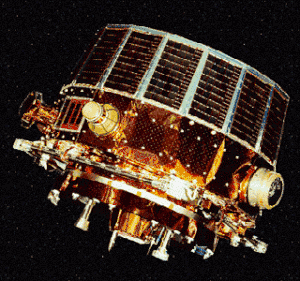Equator-S
The Equator-S satellite was a spacecraft constructed by the Max Planck Institute for Extraterrestrial Physics for the International Solar-Terrestrial Physics Science Initiative. It was operational between 2 December 1997 and 1 May 1998.[1]

 The Equator-S satellite was operational between 2 December 1997 and 1 May 1998[1] | |
| Mission type | Heliophysics |
|---|---|
| Operator | ISTP |
| COSPAR ID | 1997-075B |
| SATCAT no. | 25068 |
| Website | https://www2011.mpe.mpg.de/EQS/eq-s-home.html |
| Mission duration | 150 days [1] |
| Spacecraft properties | |
| Manufacturer | Max Planck Institute for Extraterrestrial Physics[1] |
| Launch mass | 230 kg (510 lb) [2] |
| Start of mission | |
| Launch date | 2 December 1997 |
Description
Equator-S was a low-cost mission, launched with the intention to study the Earth's magnetosphere around the equator at heights lower than 67,000 km.[1] It was located in a near-equatorial orbit, which gave Equator-S the ability to make unique observations about the interaction between the magnetosphere and interplanetary space.[3] Equator-S had a very high spin rate and was launched on an Ariane 4 rocket on 2 December 1997.[1]
The mission ended earlier than expected, having initially been intended to have a lifetime of two years. The mission was terminated on 1 May 1998 after the failure of the onboard processor system.[1]
See also
References
- "Max Planck Institute- Equator S Summary". Retrieved 9 December 2021.
- "Spacecraft Specs". MP:EquatorS Archive. Max Planck Institute. Retrieved 9 December 2021.
- "NASA: Equator-S". NASA. Retrieved 13 December 2021.